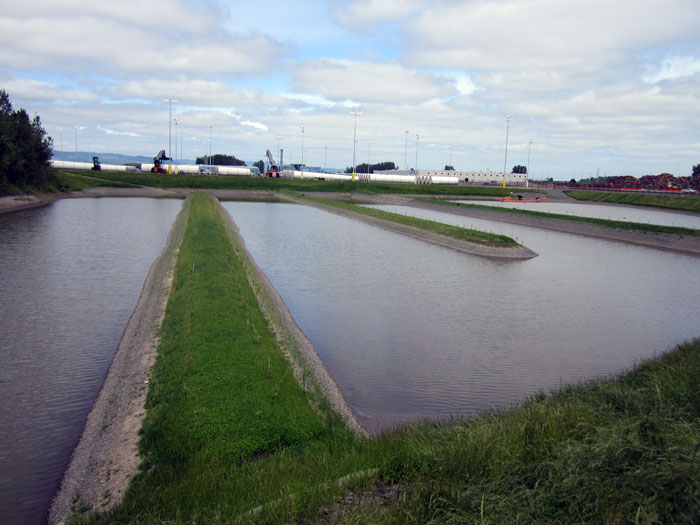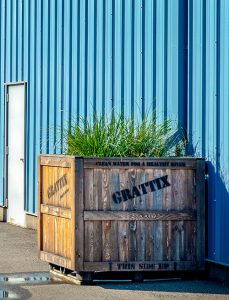Port administrative office is closed for renovations. For information on commission meeting and public tour location changes, click here.
The Port of Vancouver USA will be closed for receipt and delivery of cargo on Friday, July 4th and Monday, July 7th in honor of the Independence Day holiday. Saturday, July 5th is an ILWU No-Work holiday, so there will be no cargo activity. The admin office will also be closed on July 4th.
The Port of Vancouver USA’s innovative efforts strive to balance sustainable industrial activity, which keeps our local economies strong, with responsible waterway stewardship.

Stormwater Management
The port is committed to protecting water quality through a robust stormwater management program. We use a wide range of best management practices to treat and manage stormwater across our property—including detention ponds, biofiltration systems, hydrodynamic separators, and filter vaults.
Stormwater at the port is regulated through multiple permits issued by the Washington State Department of Ecology under the National Pollutant Discharge Elimination System (NPDES). These include:
The Western Washington Phase II Municipal Stormwater Permit, which applies to stormwater collected by the port’s municipal separate storm sewer system (MS4). This permit also includes our Stormwater Management Program, Annual Report, and Illicit Discharge Detection and Elimination (IDDE) policy.
The Industrial Stormwater General Permit, covering approximately 160 acres of marine terminal space including Terminals 2, 3, and parts of Terminal 4.
The Construction Stormwater General Permit, which applies to eligible construction projects at the port.
Drinking Water
The port’s water system provides drinking water for some industrial tenants, marine vessels, some port office buildings, irrigation and fire protection from three port-owned wells. Because these wells are located in a busy industrial area, the port takes extra steps to protect this important resource. Using an Environmental Management System (EMS), the port follows a clear plan to monitor water quality, prevent pollution, and keep the system running safely. This EMS follows international standards and helps the port continually improve how it protects its water supply.
Additional water necessary for port operations is provided by the City of Vancouver.
The port informs water users about the quality of our drinking water, including through its annual Consumer Confidence Report. Titled the Drinking Water Quality Report, the document has consistently confirmed that the port conducts water quality monitoring in compliance with state and federal health standards for drinking water (see below). For copies of all previous reports, please click the archive page below.
2024 Drinking Water Quality Report 2024 MS4 Annual ReportPFAS
Learning about PFAS
Per- and polyfluoroalkyl substances, or PFAS, are an emerging issue for water systems throughout Southwest Washington and across the country. The port is proactively testing and reporting PFAS levels. For more information about the port’s efforts on this issue, click here.
Innovations at the Port of Vancouver
The port has numerous industry-leading programs designed to preserve and protect our region’s water quality. Here are two examples of innovative designs from port employees:
 Grattix: A Rain Garden in a Box
Grattix: A Rain Garden in a Box
The Grattix is an innovative, low-cost stormwater treatment system developed by staff at the Port of Vancouver USA. Designed to reduce heavy metals in runoff from galvanized metal roofs, the Grattix is built in a plastic tote using layers of rock, sand, soil, and mulch, topped with native plants. As rainwater flows through the system, pollutants like zinc and copper are filtered out before the water reaches nearby storm drains or the Columbia River.
First tested at the port, the Grattix proved highly effective, reducing zinc levels by up to 95% and copper by as much as 85%. Its success has made it a widely used tool well beyond the port. Today, businesses, industrial tenants, schools, and community groups across the region have installed Grattix boxes to help meet water quality standards and protect local waterways.
The Grattix is easy to construct, simple to maintain, and an excellent example of how small-scale solutions can have a big environmental impact.
Download the flyer to see step-by-step instructions and learn how you can build your own.
 Floating Treatment Wetlands (FTW)
Floating Treatment Wetlands (FTW)
FTWs use buoyant material to float on top of a body of water. Vegetation is planted on top so the roots grow into the water to attract and absorb sediments and metals suspended in the water. Larger, heavier sediments and metals sink to the bottom, which is how these ponds are designed. This holistic approach can reduce the amount of copper by up to 55 percent.
3103 NW Lower River Road, Vancouver, WA 98660
PHONE360-693-3611 FAX360-735-1565 EMAIL info@portvanusa.com
SCROLL
